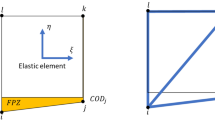Abstract
The fracture criterion according to Cockcroft and Latham in combination with the element deletion method is suitable for a numerical prediction of chevron cracks in solid forward extrusion. Conventionally, the element deletion method uses a constant critical damage value. The exceedance of this value leads to the deletion of elements from the mesh. The use of constant critical damage values leads to an inaccurate prediction of crack location and form when forming takes place at different process temperatures. Therefore, this work proposes the use of a temperature-dependent critical damage value. Implemented in Deform 2D through user subroutines and verified by experiments it is shown that the proposed methodology improves the numerical prediction of chevron crack formation for process temperatures ranging from cold to warm forming.











Similar content being viewed by others
References
Avitzur B (1968) Analysis of centre bursting defects in extrusion and wire drawing. J Eng Ind Trans ASME 90(1):79–91
Lange K (2008) Fließpressen: Wirtschaftliche Fertigung metallischer Präzisionswerkstücke. Springer, Berlin
Just H, Behrens A (2004) Investigation on the use of damage indicating criteria in FE simulations of cold and semi-hot bulk forging operations. In: Proceedings of IMECE04 (International Mechanical Engineering Congress and Exposition), November 13–20:453–461
Cockcroft N, Latham D (1968) Ductility and the workability of metals. J Inst Met 96:33–39
Chen CC, Oh SI, Kobayashi S (1979) Ductile fracture in axisymmetric extrusion and drawing. J Eng Ind Trans ASME 101:36–44
Hoffmann J, Santiago-Vega C, Vazquez VH, Altan T (2000) Prediction of ductile fracture in forward extrusion with spherical dies. Trans NAMRI/SME 28:57–62
Komori K (2003) Effect of ductile fracture criteria on chevron crack formation and evolution in drawing. Int J Mech Sci 45:141–160. doi:10.1016/S0020-7403(03)00035-3
Ko DC, Kim BM (2000) The prediction of central burst defects in extrusion and wire drawing. J Mater Process Technol 102:19–24. doi:10.1016/S0924-0136(99)00461-6
Choi JS, Lee HC, Im YT (2010) A study on chevron crack formation and evolution in a cold extrusion. J Mech Sci Technol 24:1885–1890. doi:10.1007/s12206-010-0605-z
Lee HC, Choi KH, Jung KH, Im YT (2009) Application of element deletion method for numerical analyses of cracking. JAMME 35(2):154–61
Xia YF, Quan GZ, Zhou J (2010) Effects of temperature and strain rate on critical damage value of AZ80 magnesium alloy. Trans Nonferrous Metals Soc China 20:580–583. doi:10.1016/S1003-6326(10)60542-0
Stefanik A, Dyja H, Mróz S (2011) Determination of the critical value of normalized Cockcroft-Latham criterion during multi slight rolling based on tensile test. Arch Metall Mater 56(2):543–549. doi:10.2478/v10172-011-0058-0
DIN German Institute for Standardization. DIN 969 (1997) Axial load fatigue testing - test methods and evaluation of results. 1–10
Terhorst M, Klocke F, Niebes S, Schongen F, Mattfeld P (2013) Energy-efficient solid forward extrusion through hybridization based on process-integrated resistance heating. Key Eng Mater 554–557:620–629. doi:10.4028/www.scientific.net/KEM.554-557.620
Acknowledgments
The authors would like to thank the German Federal Ministry of Economics and Technology (BMWi) for supporting this research project through the Central Innovation Programme for SMEs (ZIM). Further, we would like to thank Schondelmaier GmbH Presswerk for the great support in the achievement of the presented results.
Author information
Authors and Affiliations
Corresponding author
Rights and permissions
About this article
Cite this article
Terhorst, M., Feuerhack, A., Trauth, D. et al. Extension of the normalized Cockcroft and Latham criterion with temperature-dependent critical damage values for predicting chevron cracks in solid forward extrusion. Int J Mater Form 9, 449–456 (2016). https://doi.org/10.1007/s12289-015-1231-1
Received:
Accepted:
Published:
Issue Date:
DOI: https://doi.org/10.1007/s12289-015-1231-1




